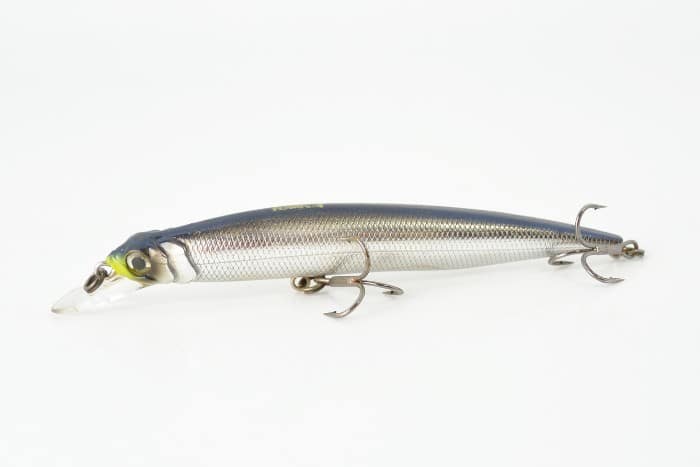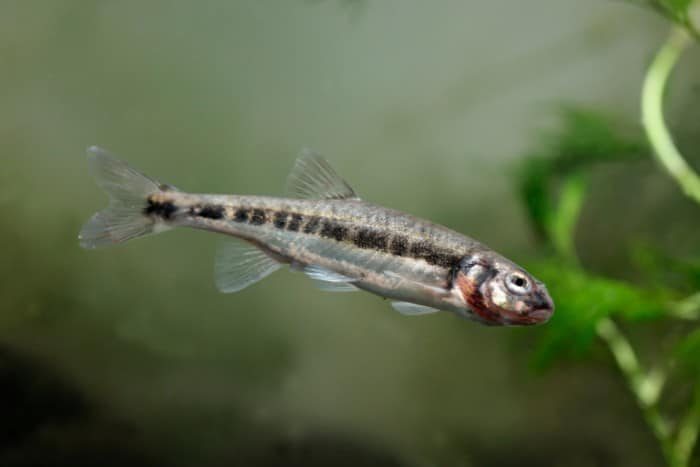In the winter, the metabolism of fish slows down. As a result, their willingness and ability to hunt diminishes. Meals don’t come as easily to fish as they do during the warmer months. If anglers are able to put a delicious minnow in front of a fish in the winter, they’ll see it as an easy meal and do little to resist it.
Some of the best minnows for ice fishing include fathead minnows, sucker minnows as well as shiner minnows. All of these minnows are easy to catch and purchase across the United States and will be useful in helping you land sunfish, crappie, walleye, pike, bass, and a variety of other fish.
Certain fish prefer particular minnows, but their preference also depends on the time of year and minnow population in the body of water.
Best Minnows For Ice Fishing
1. Shiner Minnows
“Shiners” are considered one of the minnow family’s larger-sized options. There are three types of shiners that are most commonly used in ice fishing: common, emerald, and golden shiners.
Shiner minnows can grow upwards of 10 inches long. As a result, anglers use them for fish like pike, muskie, largemouth bass, and gar.
Shiner minnows are great choices if you tip up fish, dead stick, or jig. Their large size will attract any fish in the area.
If you’re using a free hook, split shots, and a shiner, you want to make sure you are using a size 4 or 6 hook because of their size.
They can easily get off of the hook if they aren’t hooked properly, so make sure you have a large enough hook to hold them.
Whether you’re fishing deep or in shallow water, it’s hard for any fish in the area to pass up on an active shiner. When dropping a shiner into the hole, be prepared right from the beginning.
Many fish will strike shiners as they’re falling in the water column. Shiners are often found in water that’s 10-15 feet deep, so it’s not a bad idea to fish them at this depth.
In the Midwestern United States, shiner minnows are illegal to transport across state borders, so their prices have increased in recent years.
Their prevalence in the waters of Minnesota often requires surrounding states to purchase them from local bait shops in Minnesota before selling them in their own stores.
Be aware that shiner minnows don’t often survive long after purchase. You may find yourself fishing with dead minnows, but that’s not always bad!
Fish will still strike a dead minnow, but it’s not as effective as a live and active minnow.

2. Fathead Minnows
If you spend any time ice fishing in Minnesota, you’re very familiar with fathead minnows.
They are so common throughout lakes, rivers, and streams that many anglers catch their own fatheads to use as bait, which is possible all year round.
Fathead minnows rarely grow over 3 inches, and they get their name because males grow an enlarged head during the spawning season.
You can easily fish a fathead on a 1/8 or 1/32-ounce jig. The hooks are large enough to keep them attached and the jig.
Know about other jigs that you can use in our article on What To Use For Ice Fishing Jigs?
Crappie, rock bass, perch, sunfish, walleye, largemouth, and pike are all big favorites of fathead minnows. Fatheads are some of the most common minnows anglers use to tip their jigs.
Anglers will cut the large heads off the fathead minnows and attach them to spoons and jigs. Jigging with fatheads is the most common method anglers use when looking to land fish.
Fish these fatheads in 10-20 feet of water. Jigging them in 10-20 feet is an excellent method if you’re hoping to land panfish or any walleye feeding near the bottom.
Some anglers will keep them as live bait options when fishing with tip-ups or dead sticking. Either way, they are incredibly active when hooked through the back.
Plus, they’re surprisingly durable, so they’ll move and swim for quite a while, even if they’re hooked.
Anglers also don’t have to worry about half of their minnows dying within the first hour or two of purchasing them.
With a bubbler or other oxygenation methods, fathead minnows will stay alive for a few days!
3. Sucker Minnows
Sucker minnows are similar to shiner minnows in their size. They’ll grow anywhere from 3 inches to 8 inches. Many ice anglers prefer sucker minnows when they’re targeting walleye through the ice.
Sucker minnows hover close to the bottom, where walleye like to feed.
If you’re spending time in 15-25 feet of water, a large sucker minnow is the perfect choice. You can fish them on a size four or six hook.
Letting the minnow sit near the bottom below a few split shots and allowing the movement of the minnow to create the action, you should have plenty of success.
If the minnow is losing steam, you’ll have to do some of the activity on your own, but either way, they’re a good choice.
Anglers also have a ton of success when fishing sucker minnows on tip-ups and dead sticks.
If you’re finding that the minnows are too large, you have the option of cutting up the minnows into chunks and using the meat to tip a jig.
Walleye tend to like a live minnow for bait, but you will find that pieces of sucker work great for landing pike, bass, and crappie.
On the topic of live baits, do you really need them? Read our article analyzing the need of live baits for ice fishing.
Suckers are a versatile minnow species that offer anglers a chance to land more fish than they originally anticipated.
Plus, they’re hearty, so they’re going to survive and last after you make you get your hands on them.
How To Use Minnows for Ice Fishing?
Anglers have a few different options for techniques to use when ice fishing with minnows. Whether they’re alive or dead, they’re some of the most effective baits you could use.
1. Live Minnows
When you’re using live minnows and hoping to keep them active in the water, your best option is to hook them through the back near the dorsal fin.
Whether you’re fishing on a tip-up or below a few small weights, hooking a minnow through its back will keep it alive and allow it to move as much as it would like without dying too quickly.
When hooking a minnow through the back, ensure the hook’s point is facing the head. Many fish will try to eat minnows headfirst, giving you a better chance of hooking into the fish when it eats the minnow.

2. Dead Minnows
Dead minnows are great if you still want to fish with a jig. You can lip-hook a dead minnow and use the jig to create all the movement you would like.
Make sure you hook the minnow through both of the lips to ensure that it stays on the hook as long as possible.
Conclusion
Ice fishing with minnows is a great way to give yourself a chance to land fish. They’re a versatile bait, so fish of all types and sizes love eating them when they get the chance.
Whether you’re fishing a sucker, shiner, or fathead, they each provide their own unique activity and features that will give you opportunities to land a ton of fish.
Be sure to identify what the fish you’re targeting have recently been eating and make your decision based on that information.
Fish are temperamental and require different techniques and baits, so the more you can stay up to date on their desires, the better. At the end of the day, however, you know minnows are going to work!
